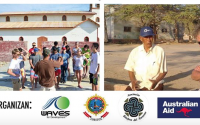"Classrooms"
09 Feb 2014by WAVES Volunteer
Four walls. Tables and desks. Fluorescent lighting. A chalkboard, or a whiteboard if we’re lucky. A computer with all the latest software, a ceiling-mounted projector, and an automatically-descending projection screen. Wi-Fi. Power outlets on all walls and even in the floors. A water fountain and bathroom down the hall. Carpet, conditioned air, and some windows.
All things found in my typical classrooms. That, plus 12 to 24 students in comfortable chairs, insulated from the outside world with the exception of whatever portals we choose to open together during that class session. I’ve taught in university classrooms like this for five years, and students (I hope) usually seem to learn what I would like them to learn. Along the way, hopefully they also develop some life skills and appreciation for broader perspectives about the world around them. But can we do even better?
An arid sand-scape. Twenty mile an hour winds, blazing sun, and 90 degree heat. A partially developed site that needs a local, sustainable material for wall construction, an on-site wastewater treatment system for water and biosolids recovery, a gray water irrigation system, native plants, and an effective system for composting organic waste.
A concrete pad packed with a dozen children, racing from one of the students to the next depending on which word is called out in English, corresponding to one of the signs they are holding with the Spanish equivalent.
A 20 foot wooden fishing boat with a captain and his 8- and 11-year old sons, teaching these students how they feed their family and make some additional money in the process. Discussing with them how he can broaden his fishing operation to offer fishing trips for the tourists that are beginning to frequent this town.
A small home with a dirt floor, interviewing the owners about their children’s respiratory problems and other health impacts caused by poor indoor air quality. And trying to prioritize their family’s need for a concrete floor over the needs of other families in the same situation.
And a sandy beach, with two instructors, 9 local children, and these college students, all clad in wetsuits, learning about water safety, fitness, and life growing up in northern Peru. Pushing those children into waves and watching them stand up with not a moment’s hesitation; giving one of them a high five as he surfs by me all the way to the beach.
Classrooms come in many forms, with some like these more effective than others. On January 11th we returned from an eight day visit to Lobitos working with WAVES for Development. Although the students were the ones that made this trip happen, I had a few goals for the trip, as well, the most important being for these seven engineering students to see that technical aspects of development and design are only a portion of what it takes to work towards societal well-being. We can usually look up the formulas for the compressive strength of a soil or calculate the friction losses in a water pipe, but you can’t look up the value of a young child becoming more healthy as a result of a concrete floor in her home, giving her the time to learn new skills and eventually start her own business. Or the tourism revenue and income brought to a small town because a young 13 year-old boy was given a surfboard and a camera, which he used to shred and photograph, respectively, one of the best waves in the world, resulting in the world knowing about the long left at Lobitos, Peru. I could maybe describe these things in a classroom, but it’s not so much about what I might see and say to students but rather about what they can see and experience for themselves in these novel classrooms. I know this much: sitting in that classroom with four walls and fluorescent lights, they can catch a glimpse. But in that sand, in that boat, in that house, and on that beach, they can see the world as it is and as it can be, with their help. Those are the classrooms that foster true learning.
Kevin Gilmore
Assistant Professor of Civil & Environmental Engineering, Bucknell University
Bucknell WAVES Corps
Tags: 2014, Biodigestor, Bucknell, Concrete Floors, Earthbags, Engineering, Kevin Gilmore, Lobitos, WAVES Corps







